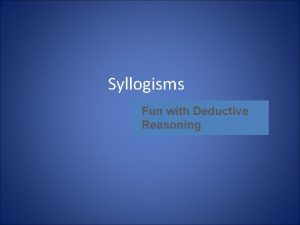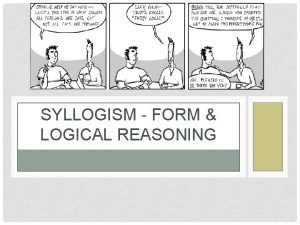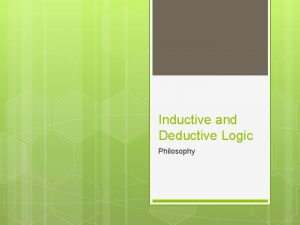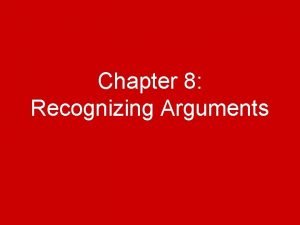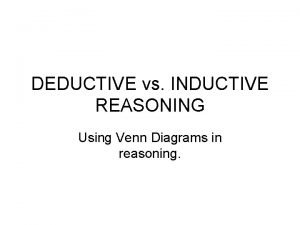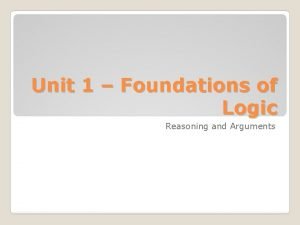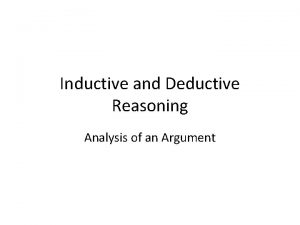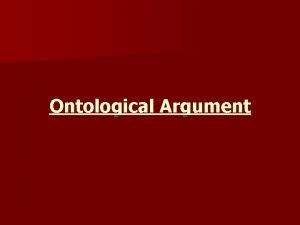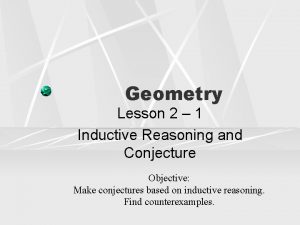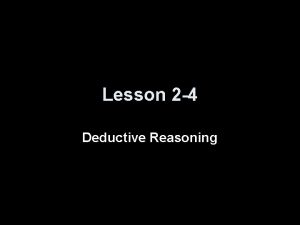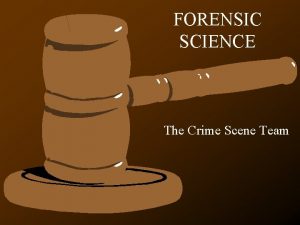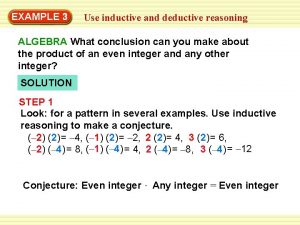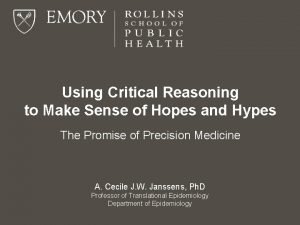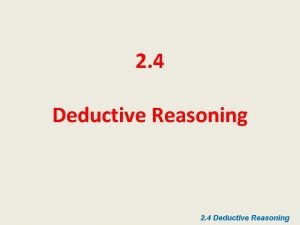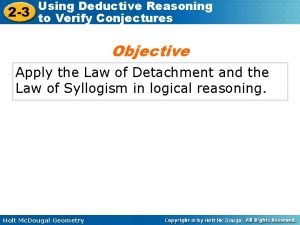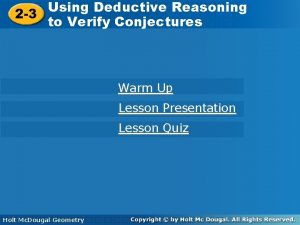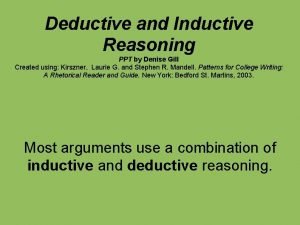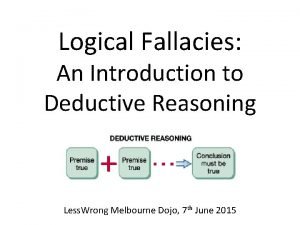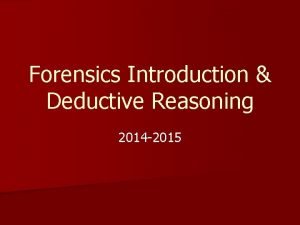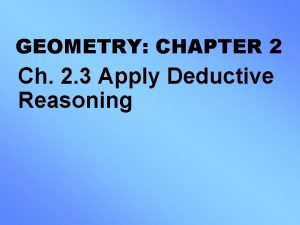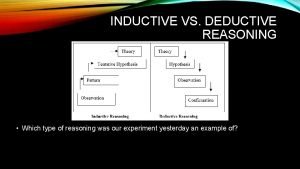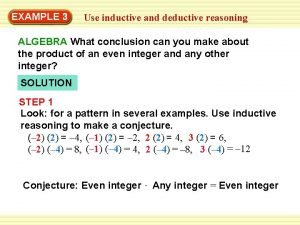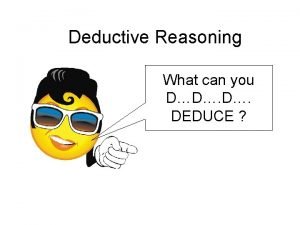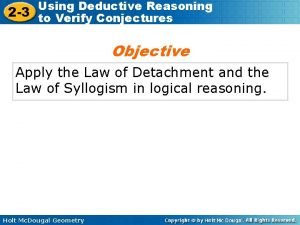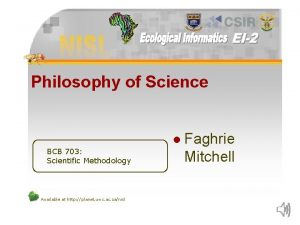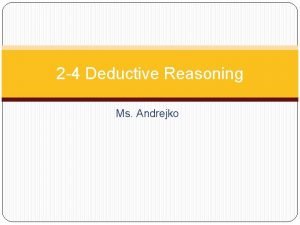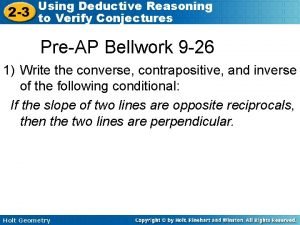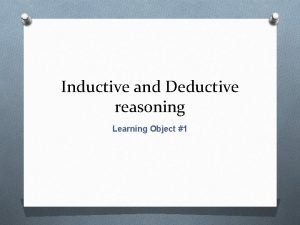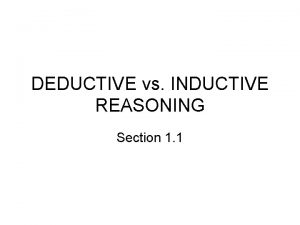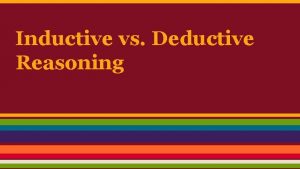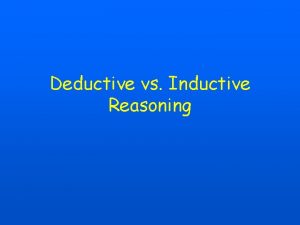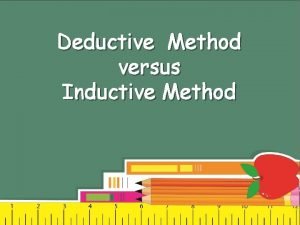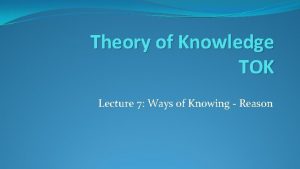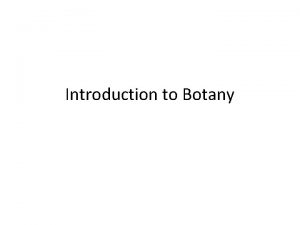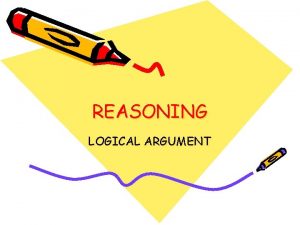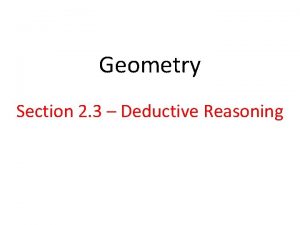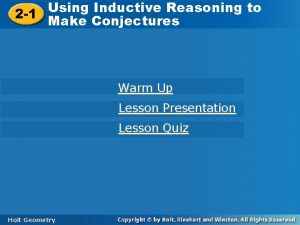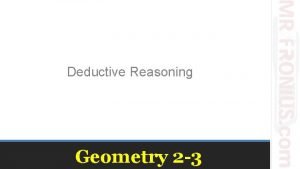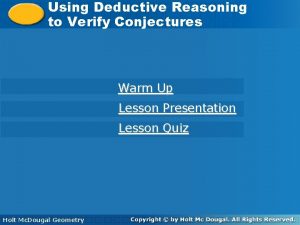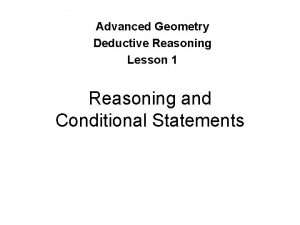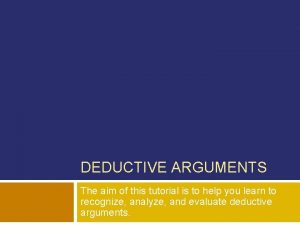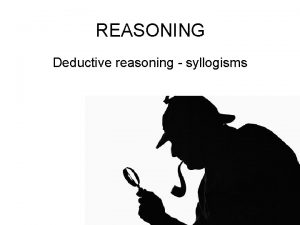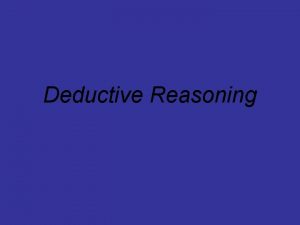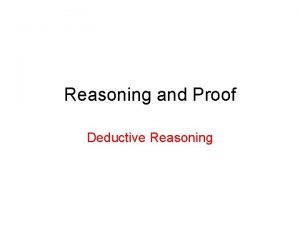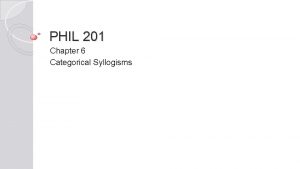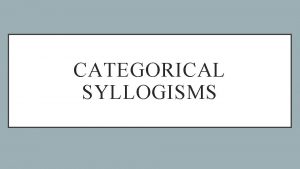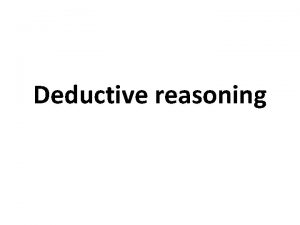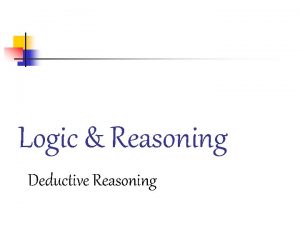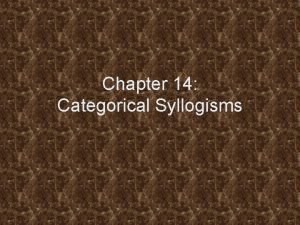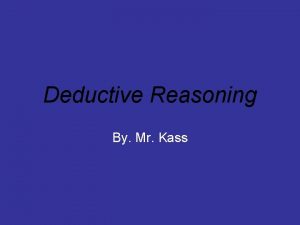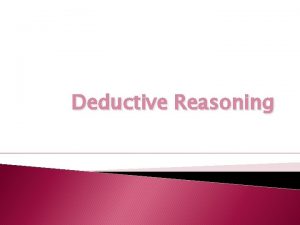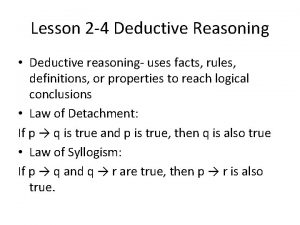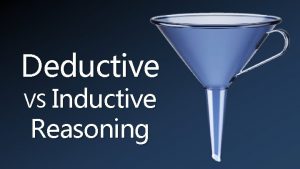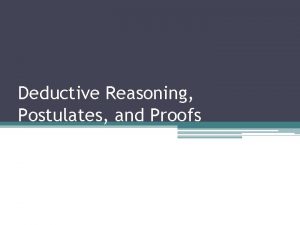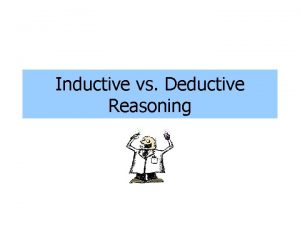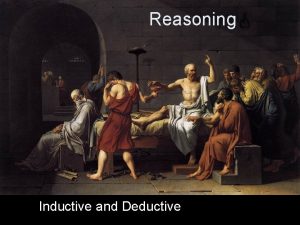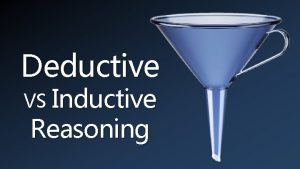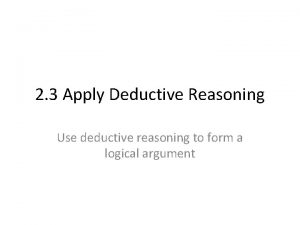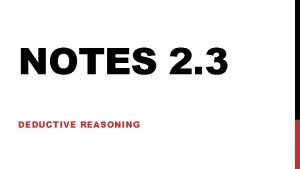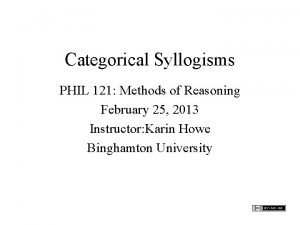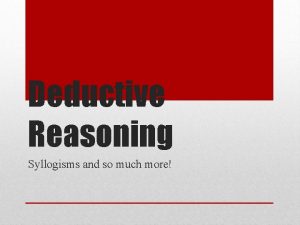Deductive Reasoning Syllogisms Categorical syllogisms A deductive argument
























































- Slides: 56

Deductive Reasoning Syllogisms Categorical syllogisms

A deductive argument is an argument in which it is thought that the premises provide a guarantee of the truth of the conclusion. In a deductive argument, the premises are intended to provide support for the conclusion that is so strong that, if the premises are true, it would be impossible for the conclusion to be false.

An argument is a connected series of statements or propositions, some of which are intended to provide support, justification or evidence for the truth of another statement or proposition. Arguments consist of one or more premises and a conclusion. The premises are those statements that are taken to provide the support or evidence; the conclusion is that which the premises allegedly support.

For example, the following is an argument: The death penalty should be adopted only if it deters murder. However, it could only do this if murderers understood the consequences of their actions before acting, and since this is not so, we must reject adopting the death penalty. The conclusion of this argument is the final statement: “we must reject adopting the death penalty. ” The other statements are the premises; they are offered as reasons or justification for this claim. The premises of an argument are sometimes also called the “data, ” the “grounds” or the “backup” given for accepting the conclusion. http: //www. iep. utm. edu/ded-ind/

Aristotle In ancient Greece, the philosopher Aristotle challenged his students with logic problems call syllogisms. A syllogism has three parts, and must be worded in a particular way. All dogs are barking animals. All poodles are dogs. Therefore, all poodles are barking animals.

• • • The first line gives you one piece of information—all dogs are barking animals. The second line gives you another piece of information—all poodles are dogs. Each of the first two statements in a syllogism is called a premise. The information is put together to get the conclusion. The conclusion is the third statement in a syllogism. If the conclusion is supported by the information in the premises, it is valid.

Valid or Invalid? All poodles are dogs. All poodles are barking animals. Therefore, all dogs are barking animals. First premise Second premise But when you put the information from the two premises together, you don’t have enough information to conclude anything about all dogs. Invalid

The three statements in this type of logic problem are called an argument. It has a conclusion that must be supported by two premises. There are three different categories, or sets, in a syllogism. In the syllogism about dogs, the three sets are dogs, barking animals, and poodles. It is a rule that each statement in a syllogism must contain two of the three sets. It also is a rule that each set must be used only twice.

Sets in Syllogisms What are the sets in this syllogism? All flowers are pretty: _______and______ All daffodils are flowers: _______and_____ Therefore, all daffodils are pretty: _____&____ Is this a valid syllogism?

Sets in Syllogisms What are the sets in this syllogism? All flowers are pretty: flowers and pretty All daffodils are flowers: daffodils and flowers Therefore, all daffodils are pretty: daffodils and pretty Is this a valid syllogism? Valid

Another Syllogism All flowers are pretty. All daffodils are pretty. Therefore, all daffodils are flowers. Is it valid?

Another Syllogism All flowers are pretty. All daffodils are pretty. Therefore, all daffodils are flowers. Is it valid? No The two premises give no Information about all daffodils Being flowers or flowers being Daffodils.

Valid or Invalid? All dogs have three legs. All ducks are dogs. Therefore, all ducks have three legs. All dragons are green. All green things are ugly. There all dragons are ugly.

Valid or Invalid? All dogs have three legs. All ducks are dogs. Therefore, all ducks have three legs. Valid All dragons are green. All green things are ugly. There all dragons are ugly. Valid

A syllogism is a type of formal logical argument. Syllogisms come in three sentences, each with a subject and predicate: Major Premise: Subject, predicate Minor Premise: Subject, predicate Conclusion: Subject, predicate

The major premise is the first premise in a syllogism and contains both major term and the middle term. The major term is the predicate term of the conclusion and the middle term is the term that occurs in both premises, but not in the conclusion. The minor premise is the second premise in a syllogism and contains both the minor term and the middle term. The minor term is the subject term of the conclusion.

Major premise: All men are mortal. Minor premise: Socrates is a man. Conclusion: Socrates is mortal. Each of the three distinct terms represents a category, in this example, "men, " "mortal, " and "Socrates. " "Mortal" is the major term; "Socrates", the minor term. The premises also have one term in common with each other, which is known as the middle term in this example, "man. "

Major premise: All mortals die. Minor premise: All men are mortals. Conclusion: All men die. Here, the major term is "die", the minor term is "men, " and the middle term is "mortals". Both of the premises are universal.

All animals are mortal. All men are animals. All men are mortal. No reptiles have fur. All snakes are reptiles. No snakes have fur. No homework is fun. Some reading is homework. Some reading is not fun

The formal fallacy of illicit minor is committed in categorical syllogisms when the minor term appears in the conclusion, but not in the minor premise. All cats are animals. All cats are pets. Therefore, all animals are pets.

All cats are mammals This animal is a cat Therefore, this cat is a mammal.

All humans are mortal, the major premise, I am a human, the minor premise, therefore, I am mortal

Major premise: All asteroids are made of rock. Minor premise: Ceres is an asteroid. Conclusion: Ceres is made of rock. Major premise: No cat enjoys the company of snakes. Minor premise: Fluffy enjoys the company of snakes. Conclusion: Fluffy is not a cat. Major premise: I will not eat anything that smells like feet. Minor premise: Some kinds of cheese smell like feet. Conclusion: There are some kinds of cheese I will not eat

Add the Conclusion All children are TV watchers. No TV watchers are pigs. Therefore, All carrots are vegetables. All vegetables are nutritious. Therefore,

Add the Conclusion All children are TV watchers. No TV watchers are pigs. Therefore, No children are pigs or No pigs are children. All carrots are vegetables. All vegetables are nutritious. Therefore, All carrots are nutritious.

More. . . No human beings are fish. All trout are fish. Therefore, Some good students are female. All good students are hard workers. Therefore,

More. . . No human beings are fish. All trout are fish. Therefore, No human beings are trout or no trout are human beings. Some good students are female. All good students are hard workers. Therefore Some females are hard workers or some hard workers are females.

All fragile things are breakable things. Some glasses are fragile things. Therefore All mammals are warm-blooded animals. All whales are mammals. Therefore All books are things with pages. Some books are mysteries. Therefore

All flowers are pretty objects. All pansies are flowers. Therefore No animals are plants. All sheep are animals. Therefore

Possible Answers therefore glasses are breakable whales are warm blooded mysteries have pages pansies are pretty objects sheep are not plants

Complete syllogism handout and Write two original syllogisms.

Deductive Reasoning

• • • Deductive reasoning is one of the two basic forms of valid reasoning. While inductive reasoning argues from the particular to the general, deductive reasoning argues from the general to a specific instance. The basic idea is that if something is true of a class of things in general, this truth applies to all legitimate members of that class. The key, then, is to be able to properly identify members of the class. Miscategorizing will result in invalid conclusions.

• • • Deductive reasoning works from the more general to the more specific. Sometimes this is informally called a "topdown" approach. We might begin with thinking up a theory about our topic of interest. We then narrow that down into more specific hypotheses that we can test. We narrow down even further when we collect observations to address the hypotheses. This ultimately leads us to be able to test the hypotheses with specific data -- a confirmation (or not) of our original theories.

Gravity makes things fall. The apple that hit my head was due to gravity. There is a law against smoking. Stop it now.


She is Mary Jane’s grandmother She is Sarah’s sister Mary is a bricklayer


Two of the boys row over, leaving the third one behind. On the other side, one boy gets Out of the boat, and the other one rows back. He picks up the boy who was left behind. They row over to the other side. A C B


Sue Rawls and Terry Peters 14 years old 7 years old

Two fathers and two sons have a total of $30 between them. Each man has $10. Explain. A total of $30 and each man having $10 suggests a total of three individuals. Father/son status isn't as certain, as one man may be both at once. A son/grandson, father/son and father/grandfather solves the apparent dilemma quite nicely.

Matrix Logic To do matrix logic problems, start by gathering information from clues. These clues can be tricky. One clue may give you only a little information by itself, but may give more information when you fit it together with another clue.

Candy, Candy 1. Tina hates chocolate bars. 2. Kathy eats taffy. 3. Jake hates lollipops.

Candy, Candy To record the information in this problem, record on a chart called a matrix. Write down the children’s names in the boxes on the side, and the three kinds of candy in the boxes on the top. Choc. Bars Tina Kathy Jake X Taffy Lollipops

Candy, Candy Write Yes where Kathy and taffy meet. The mark X in the other two boxes next to Kathy’s name. Finally, mark X where Tina and taffy meet and where Jake and taffy meet. Choc. Bars Tina X Kathy X Jake Taffy Lollipops Yes X X

Candy, Candy Mark X in the box where Jake and lollipops meet. Now you can see that there’s only one space left next to Tina’s name— lollipops. Mark that Yes. And there’s only one space left next to Jake’s name– chocolate bars. Mark that box Yes. Choc. Bars Taffy Lollipops Tina X X Yes Kathy X Yes X Jake Yes X X

Candy, Candy The matrix logic problem is solved. Choc. Bars Taffy Lollipops Tina X X Yes Kathy X yes X Jake Yes X X

Flowers Karen, Derek, Fay, Tanya, and Scott each have a special favorite flower. No two of them have the same favorite. Which person matches which flower? 1. 2. 3. 4. 5. 6. Karen’s favorite is not the tulip. Derek hates tulips and roses. Someone really likes daisies. Fay likes violets. Tanya is allergic to carnations. Scott likes the flower to which Tanya is allergic

Flowers Karen, Derek, Fay, Tina, and Scott each have a special favorite flower. No two of them have the same favorite. Which person matches which flower? 1. 2. 3. 4. 5. 6. Karen’s favorite is not the tulip. Derek hates tulips and roses. Someone really likes daisies. Fay likes violets. Tina is allergic to carnations. Scott likes the flower to which Tanya is allergic Roses carnations violets tulips daisies Karen Yes X X x X Derek X X Yes Fay X x Yes X X Tina X X X Yes X


X X X X X O X X X X X X


Create an original matrix logic problem using the following information. This Assignment is due Thursday.

Create an original matrix logic problem using the following information. This Assignment is due Thursday. Create an original Matrix Logic problem. 1. Use the names Pat, James, and Lori 2. Use the foods pizza, fish and hotdogs.

That’s All!
 Every quiz has been easy. therefore the quiz will be easy
Every quiz has been easy. therefore the quiz will be easy Difference between inductive and deductive reasoning
Difference between inductive and deductive reasoning Example of deductive argument
Example of deductive argument Deductive reasoning definition
Deductive reasoning definition Inductive vs deductive geometry
Inductive vs deductive geometry Inductive method
Inductive method Standard form syllogism
Standard form syllogism Funny syllogisms
Funny syllogisms Syllogism meaning
Syllogism meaning Inductive syllogism
Inductive syllogism Is the teleological argument inductive or deductive
Is the teleological argument inductive or deductive Example of a deductive argument
Example of a deductive argument Deductive argument indicator words
Deductive argument indicator words Venn diagram deductive reasoning
Venn diagram deductive reasoning Deductive argument examples
Deductive argument examples Inductive reasoning definition
Inductive reasoning definition Deductive reasoning definition forensic science
Deductive reasoning definition forensic science Inductive vs deductive reasoning math
Inductive vs deductive reasoning math Ontological argument
Ontological argument Logical reasoning lesson 2-1
Logical reasoning lesson 2-1 Lesson 2-4 deductive reasoning
Lesson 2-4 deductive reasoning Deductive reasoning crime scene investigation
Deductive reasoning crime scene investigation Inductive reasoning algebra
Inductive reasoning algebra Types of logical reasoning
Types of logical reasoning 2-4 deductive reasoning
2-4 deductive reasoning Using deductive reasoning to verify conjectures
Using deductive reasoning to verify conjectures Using deductive reasoning to verify conjectures
Using deductive reasoning to verify conjectures Inductive vs deductive reasoning
Inductive vs deductive reasoning Deductive reasoning fallacy
Deductive reasoning fallacy Deductive reasoning definition forensics
Deductive reasoning definition forensics Deductive reasoning definition geometry
Deductive reasoning definition geometry Inductive vs deductive reasoning
Inductive vs deductive reasoning Deductive reasoning algebra
Deductive reasoning algebra Deductive reasoning
Deductive reasoning 2-3 using deductive reasoning to verify conjectures
2-3 using deductive reasoning to verify conjectures What is philosophy
What is philosophy 2-4 practice deductive reasoning
2-4 practice deductive reasoning Using deductive reasoning to verify conjectures
Using deductive reasoning to verify conjectures What is inductive reasoning?
What is inductive reasoning? Deductive logic definition
Deductive logic definition Deduction vs induction
Deduction vs induction Inductive reasoning involves
Inductive reasoning involves Deductive reasoning venn diagrams
Deductive reasoning venn diagrams Inductive and deductive reasoning venn diagram
Inductive and deductive reasoning venn diagram Deductive reasoning ap lang
Deductive reasoning ap lang Inductive method
Inductive method Hypothetico deductive method
Hypothetico deductive method What is deductive reasoning
What is deductive reasoning Deductive reasoning lab
Deductive reasoning lab Kesimpulan umum secara aruhan
Kesimpulan umum secara aruhan Deductive method
Deductive method Inductive literature review
Inductive literature review Inductive reasoning
Inductive reasoning 2-3 deductive reasoning
2-3 deductive reasoning Using deductive reasoning to verify conjectures
Using deductive reasoning to verify conjectures Make a conjecture based on the given information
Make a conjecture based on the given information Types of deductive reasoning
Types of deductive reasoning







